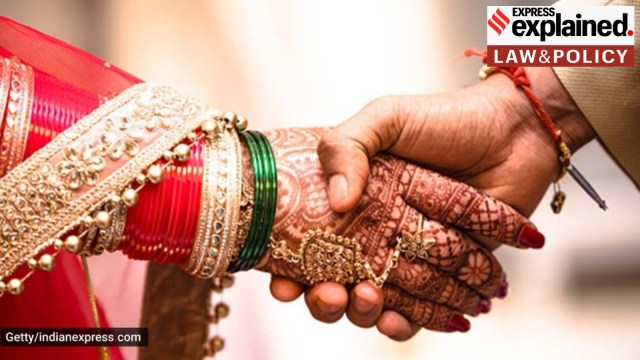© The Indian Express Pvt Ltd
Latest Comment
Post Comment
Read Comments
 A Bench comprising Justices Vikram Nath and Sandeep Mehta said that until the rules are framed, states and UTs must accept and register Anand Karaj marriages under existing marriage registration laws.
A Bench comprising Justices Vikram Nath and Sandeep Mehta said that until the rules are framed, states and UTs must accept and register Anand Karaj marriages under existing marriage registration laws.
Earlier this month, the Supreme Court directed 17 states and eight Union Territories (UTs), which are yet to frame rules for the registration of Sikh marriages under the Anand Marriage Act, 1909, to do so within four months.
A Bench comprising Justices Vikram Nath and Sandeep Mehta said that until the rules are framed, states and UTs must accept and register Anand Karaj marriages under existing marriage registration laws.
This judgment is meant to ensure that Sikh couples across India can legally register their marriages under their own religious tradition, a right that has not
Anand Karaj, literally “blissful union”, is the prescribed form of marriage in the Sikh faith. The ceremony is conducted in the presence of the Guru Granth Sahib, the holy scripture of the Sikhs.
To solemnise the marriage, the couple walks around the Guru Granth Sahib four times, as hymns, known as laavan, are recited. The four chosen verses, composed by Guru Ram Das, the fourth Sikh Guru, outline the spiritual journey of a married couple.
In the early 20th century, efforts by the Sikh community for legal recognition of their distinct marriage ceremony, specifically, to differentiate it from Hindu rituals, led to the enactment of the Anand Marriage Act in 1909.
The Act, only a page long, served one primary purpose: to legally sanctify all marriages solemnised through the Anand Karaj ceremony. Among other things, however, the original Act did not include provisions for the registration of these marriages.
This gap was addressed over a century later with the Anand Marriage (Amendment) Act, 2012. The Amendment introduced Section 6, which directed state governments to create rules for the registration of Anand Karaj marriages. Once registered under the Act, a couple would not need to register their marriage under any other law.
But more than a decade after the Amendment was passed, most States and UTs had still not framed rules for registration of Anand Karaj marriages.
In 2022, Amanjot Singh Chaddha, a Nainital-based advocate, filed a petition before the SC pointing to the “inaction” by several states. The petition argued that the failure to notify rules was denying Sikh couples a statutory facility and creating “uneven access” to their rights.
Without a marriage certificate, couples faced hurdles in matters of residence, maintenance, inheritance, and succession. The petition contended that this inaction disenfranchised a large section of society from the benefits of a central law.
Earlier this month, the SC addressed this gap and issued a comprehensive set of directions to ensure the law is implemented nationwide. The SC Bench said, “In a secular framework that respects religious identity while ensuring civic equality, the law must provide a neutral and workable route by which marriages solemnised by Anand Karaj are recorded and certified on the same footing as other marriages.”
The court imposed a “positive duty on every State Government to create a workable registration machinery”. It noted that the failure to frame rules “withholds the very evidentiary and administrative benefits that Parliament has conferred”.
Moreover, the court made it clear that no application for registration can be refused solely on the ground that the state has not yet notified the rules.
In reality, most Sikh couples today are constrained to register their marriages under the Hindu Marriage Act, 1955 which also recognises Sikh marriages. As such, neither the original Act nor the 2012 Amendment nor even the latest SC directions address longstanding concerns of the Sikh community about maintaining distinct identity of religion.
For one, while the Act provides a framework for registration, it does not include provisions for divorce or other matrimonial disputes. As a result, Sikhs seeking divorce must turn to the Hindu Marriage Act 1955 to dissolve their marriage.
This was an issue that was flagged in 2012, when the Amendment was brought in. “The Anand Karaj takes place in the presence of Guru Granth Sahib makes it imperative for an individual to uphold his marital ties all his/her life,” then Akal Takht Jathedar Giani Gurbachan Singh had said.
Sikh preacher Baljit Singh Daduwal told The Indian Express that such an issue “must be resolved and it can only be done if community leaders and scholars would sit together”. “Sikhs need a complete marriage act,” he said, adding that at the moment the “Anand Marriage Act is just a facade” behind which lies the “Hindu Marriage Act”.
The primary problem, as Gurcharan Singh Grewal, former SGPC general secretary, explained, is that the Act is only a page long.
“It contains barely ten points. But if you look at the Hindu Marriage Act, it runs to over a hundred pages. That Act considers every detail and specifies what will happen if a dispute arises, and how rights and customs will be recognised. These details are not spelt out in the Anand Marriage Act,” he said.
“The real pain is that Sikhs are not recognised as a distinct community in the same way Muslims and Christians,” Grewal said. “The Anand Act was made, but half-heartedly, without addressing critical issues. It reflects more of a symbolic recognition rather than giving Sikhs practical legal rights as a separate community.”
When asked about the lack of clarity regarding the concept of divorce, Grewal argued that such matters will be discussed when the Act is prepared. “But for that you will have to free Sikhs from Hindu Marriage act.”


